
The Beginning of Life/Art: Cloth Weaves Our Times, from Aomori
May 7 (Thu)- August 30 (Sun), 2020
LIN Gieh-Wen/Labay Eyong
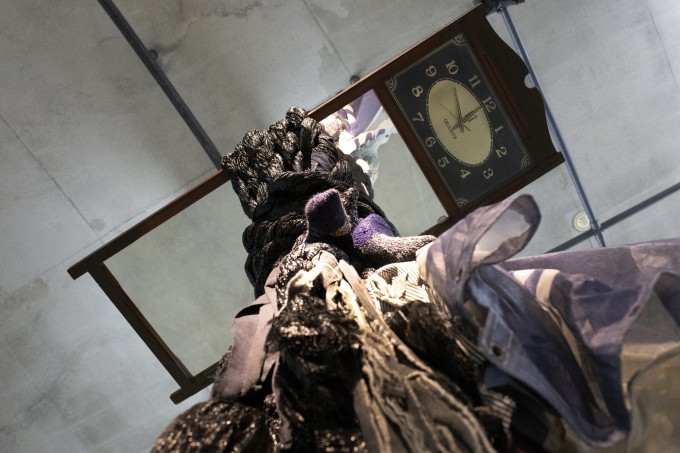
Open the Rope, 2020 Photo: Delphine Parodi
I had untied the knot in my life
Knots that restrained me resulted in wasting my time and energy
Stains and dirt falling off of me
At this very moment I am moving towards the way of reconciliation
Until I met you
My great-grandfather is Japanese. His presence was like a spirit that is hardly ever felt in our family. History has left a hidden scar through my blood but had also gave me life.
I created the way of reconciliation through art and labor although hatred had narrowed my vision. The work of Open the Rope shows the cycle of destroying and rearranging. Mixing and twisting different spaces with different timelines creating a knot in the end. As it is like an ancient knot memoir with family members’ pasts recorded in it. Also it feels like a ceremony to inform ancestors that we know about your existence.
―LIN Gieh-Wen/Labay Eyong
As a member of the Truku, one of the indigenous peoples of Taiwan, LIN Gieh-Wen/Labay Eyong creates sculptural installations, using the traditional weaving techniques. While occasionally collaborating with weavers in the Truku community she belongs to, she poses questions on the physicality and identities of women through her work. Japan ruled Taiwan in the past (from 1895 to 1945) and many Japanese people migrated there. As a colony, Japan modernized Taiwan, put things in order, and at the same time, we took away their lands, languages, and cultures.
Due to the coronavirus (COVID-19) pandemic, the artist has not been able to come to Japan and install her work yet, unfortunately. However, upon visiting Aomori in February this year for her research, she came to know about Aomori Sakiori and Sashiko, which share similarities with textiles and knitted goods made by the Taiwanese indigenous people in their forms and roles they play in their cultures. She learned how they were made, and took different materials, such as plastic tarpaulin, used clothes, and fishing nets, which are commonly used but their designs vary in each country, back to Taiwan. The relationship between Taiwan and Japan is also inscribed in her family history. A mirror that had been reflecting her family members and a clock that had been marking the passage of time with them. Things, which are created by people's comings and goings, get tossed around by large currents of history, and the ways in which people perceive and interpret them also change. Through her contemporary art practice, Labay seems to confront the essence of things and deep feelings within her.
The approach she is planning to take in Gallery B is to use the objects selected from the collection of important cultural properties, which are connected to people’s births and memories, such as old clocks, chests, and Entsuko (cradles), put them together as a large sculpture, and cover it with large pieces of cloth, which the Truku women traditionally weave. Cloth continuously wraps people from their birth until their death. By covering the sculpture with the large pieces of cloth, which hold many people’s feelings and wishes, the artist is perhaps trying to tell us the mystery of life existing here and now and its preciousness.
Text: KEINO Yuka, Translation: NAGASAKA Aki


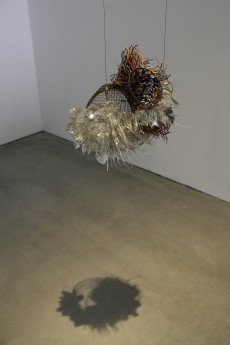
COVID-19, 2020 Photo: Delphine Parodi
いのちの裂け目ー布が描き出す近代、青森から
2020年5月7日(木)~8月30日(日)
林介文(リン・ジェーウェン/ラバイ・イヨン)
LIN Gieh-Wen / Labay Eyong
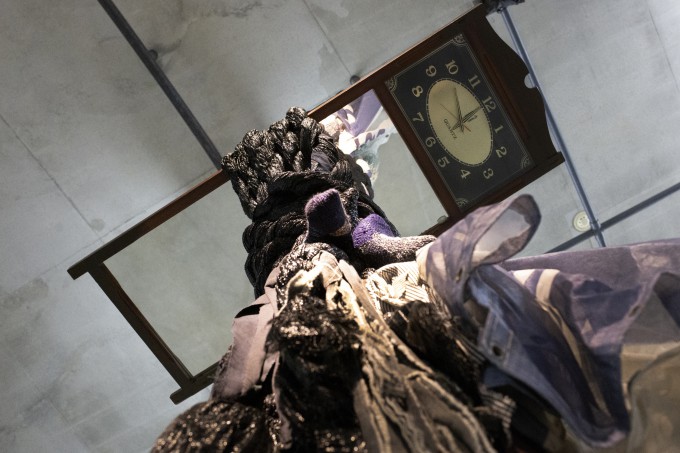
≪解縄(ときなわ)≫2020年
撮影:デルフィン・パロディ
我解開粗繩
那些沾滿時間與力量的繩
污漬不斷掉落
此時我正朝著合解的方向
遇見你~
我的曾曾祖父是日本人,他在我的家族裡如同一個不存在的隱形人。歷史在我的血液裡藏了一道疤,卻也給了我生命。
我透過藝術與勞動製造合解,隨然恨意早已變的模糊。解繩這件作品透過反覆的動做破壞後再重組,最後將不同地方(台灣 日本)與不同時間(過去 現在)的物件扭在一起,最後還原出一個繩結的模樣。如同古老的繩結記事,記載了家族的歷史,也如同一場儀式,告知祖先我知道你的存在。
―林介文
粗縄(ロープ)をほどく
時間と力に満ちた縄を
汚れは落ち続け、
私の中のわだかまりは解けていく
そしてあなたに会うのだ
私の曾曾祖父は日本人だ。家族の中で存在感はない。歴史は私の血の中にその傷を残し、そして命をくれた。
私は芸術としての労働を通してそのわだかまりを解く。憎む気持ちはぼやける。破壊と再編成を繰り返し、最後には違う場所(台湾と日本)や違う時間(過去と現在)でオブジェクトをひねり、結び目を復元する。それは、古代の結縄(けつじょう:縄の結び方で意思を通じ合い、記憶の便りとしたこと)のように、あなたの存在を知っていることを伝え、家族の歴史を記録する儀式のようなものだ。
―林介文(リン・ジェ―ウェン/ラバイ・イヨン)
林介文(リン・ジェ―ウェン/ラバイ・イヨン)は台湾原住民の太魯閣(トゥルク)族の一員として、伝統的な織物の技法を用いながら、彫刻的なインスタレーションを手掛けています。時にコミュニティの織り手たちと協働しながら、女性の身体性やアイデンティティーを問うアーティストです。かつて日本は台湾を統治し(1895-1945年)、日本から多数の人々が移住して植民地としての近代的整備を行い、彼らの土地や言語、文化を奪った歴史があります。
新型コロナウイルス感染症の流行により、残念ながら作家が来日しての作品設営が、現在叶っていません。しかしラバイは今年2月に青森をリサーチに訪れた際、台湾原住民族の織りや編み物と形やあり方の類似が認められる青森の裂織や刺し子を目にして、その作られ方を知るとともに、ビニールシートや古着、漁業の網など、どこでも日常的に使用されているが、それぞれの国で普及しているデザインが異なる素材を持ち帰りました。自身の家族にも刻まれている、台湾と日本の関係。家族を見つめてきた鏡と、同じ時を刻んできた時計。人と人が行き交うことによって生じることは、時に歴史のような大きな流れによって翻弄されたり、その見られ方や解釈が変わってしまったり。ラバイは現代美術の作品制作を通して、物事の本質や自分の深い感情に向き合おうとするかのようです。
彼女がギャラリーBで展開を予定しているのは、文化財の中から古い時計や箪笥、えんつこ(ゆりかご)など、人の誕生や記憶と関わるものを選び、それを大きな彫刻のように配置し、そこに太魯閣の女性たちが伝統的に織っている布をかけるというアプローチです。生まれた時から、死を迎えるまで人を包み続ける布。様々な人の思いが織り込まれている布をかけることによって、今ここにある生の不思議やかけがえのなさを語りかけようとしているのかもしれません。
テキスト:慶野結香
中日翻訳:李淳益
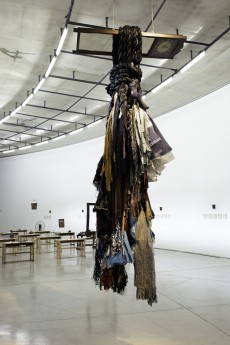
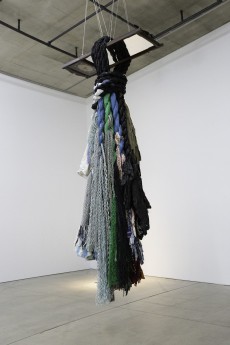

≪COVID-19≫2020年 撮影:デルフィン・パロディ
